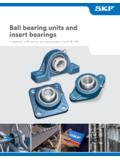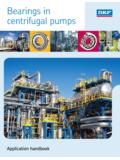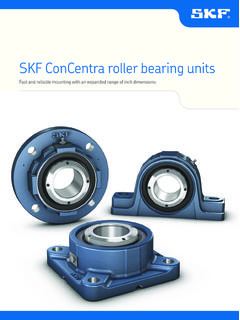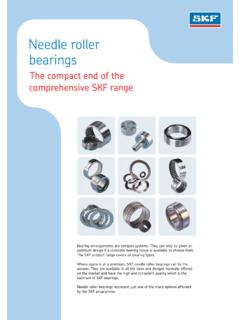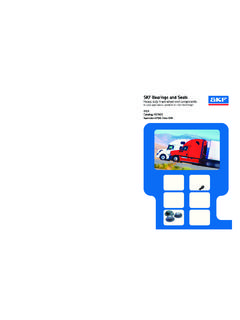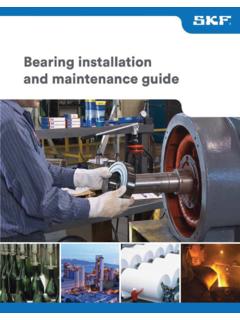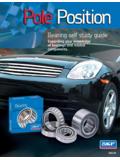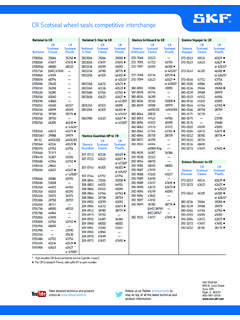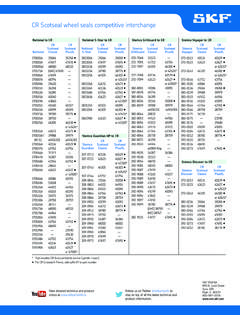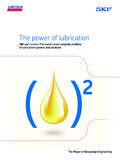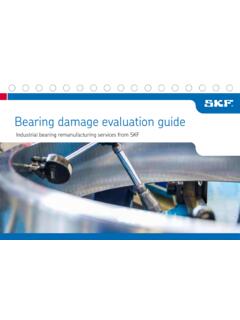Transcription of Fig. 1 - SKF
1 LLFig. 1 Fig. 2 Back-to-back arrangementsFig. 3 Face-to-face arrangementsThere may be some applications where the bearing arrangement needs to be preloaded requires a negative operating clear-ance. In applications such as machine tool spindles, automotive differentials and elec-tric motors, preload enhances stiffness or precise shaft positioning. Preload can be obtained with a spring or by adjustment ( by a nut). Springs are also used to provide a minimum load on lightly loaded is typically expressed as a force, but can also be expressed as a distance (path).Empirical preload values can be obtained from proven designs and then applied to similar designs.
2 For new designs, SKF rec-ommends calculating the preload force and checking if its appropriate by testing the application. Generally, it is not always possi-ble to identify all inluencing factors in oper-ation fully during the design stage and adjustments may be necessary. The accu-racy of the calculated results depends on how closely the estimated operating tem-perature and elastic behaviour of the associ-ated components most importantly the housing match the actual operating considerationsDepending on the bearing type, preload may be either radial or axial. Cylindrical roller bearings, for example, can be preloaded radially only, because of their design, while thrust ball and cylindrical roller thrust bear-ings can be preloaded axially only.
3 Single row angular contact ball bearings and tapered roller bearings (ig. 1) are generally preloaded axially by mounting them against a second bearing of the same type and size in a back-to -back (load lines diverge) or face- to- face (load lines converge) arrange-ment. Deep groove ball bearings can also be bearing preload Back -to-back arrangementFace-to-face arrangementLL1 preloaded axially in this case, the bearings have a greater radial internal clearance (C3 or C4) so that a contact angle is obtained. For both tapered roller and angular con-tact ball bearings, the distance L between the pressure centres is longer when the bearings are arranged back -to -back (ig.)
4 2) compared with bearings arranged face -to - face (ig. 3). This means that bearings arranged back -to -back can accommodate relatively large tilting moments even if the dis tance between the bearing centres is relatively short. The radial loads and bearing elastic displacements resulting from a moment load are smaller for bearings arranged back -to -back than when arranged face -to during operation the shaft temperature is higher than the housing temperature, the preload, which was adjusted at ambient temperature during mounting, will change. Depending on the distance between the bearings and the type of arrangement (face-to-face or back-to-back) the preload may increase or decrease.
5 In any case, thermal expansion of the inner ring in the radial direction leads to increase of the preload. Thermal expansion in the axial direction increases the preload when the bearings are face -to -face, but is reduced for back -to- back on the distance between the bearings, and provided the coeficient of thermal expansion is the same for the bear-ings and associated components, thermal expansion in both the radial and axial directions can cancel each other out so that preload remains unchanged for back-to-back arrangements independent of operating of bearing preloadThe primary beneits resulting from preload include but are not limited to.
6 Enhanced stiffness reduced noise levels improved shaft guidance compensation for wear and settling extended bearing service lifeEnhanced stiffnessBearing stiffness [kN/mm] is deined as the ratio of the force acting on the bearing to the elastic deformation in the bearing . The elastic deformation caused by a load in preloaded bearings is smaller for a given load range than for bearings that are not noise levelsAs operating clearance in a bearing decreases, rolling elements in the unloaded zone become loaded, which reduces noise levels in shaft guidancePreloaded bearings provide more accurate shaft guidance because preload provides a higher degree of stiffness, which limits the ability of the shaft to delect under load.
7 For example, preloading the bearings in a differ-ential results in increased stiffness, which limits gear mesh variation. This minimizes dynamic forces and reduces noise levels, which can extend the service life of the for wear and settlingWear and settling between mating surfaces in an adjusted bearing arrangement during running-in leads to clearance. This can be compensated for with bearing service lifeProvided the preload is properly set in an adjusted bearing arrangement, the opera-tional reliability can be enhanced, because of a more favourable load distribution in the bearings, which can extend bearing service life.
8 Setting the preload too high will overload the bearing , lead to higher friction and nega-tively influence bearing life. 2 Preload in adjusted bearing arrangements with single row angular contact ball or tapered roller bearings When determining preload, the preload force required to provide an optimum com-bination of stiffness, bearing service life and operational reliability should be calculated irst. Then calculate the preload force to be used when adjusting the bearings during mounting; the bearings should be at ambient temperature and should not be subjected to any other appropriate preload at normal operat-ing temperature depends on the bearing load.
9 A single row angular contact ball bearing or a tapered roller bearing can accommodate radial and axial loads simultaneously. Under radial load, these bearings produce an inter-nal axial load which must be accommodated by a second bearing facing the opposite direction. Purely radial displacement of one bearing ring relative to the other means that half of the rolling elements are under load. The internal axial load produced in the bearing can be determined by: for single row angular contact ball bearings Fa = R Fr for single row tapered roller bearings Fa = 0,5 Fr / YwhereFa = axial bearing load (ig.)
10 4) Fr = radial bearing load (ig. 4)R = variable depending on the contact angle: 20 contact angle (sufix AB) R = 0,50 25 contact angle (sufix AC) R = 0,57 30 contact angle (sufix A) R = 0,66 40 contact angle (sufix B) R = 0,88Y = calculation factor ( product table Tapered roller bearings, single row)When a single bearing is subjected to a radial load Fr, an axial load Fa (external) of the same magnitude as the internal axial load must be applied to the bearing if the basic load rating is to be fully exploited. If the applied external load is lighter, fewer rolling elements will be supporting the load and the load carrying capacity of the bearing is cor-respondingly an adjusted bearing arrangement consisting of two single row angular contact ball bearings or two tapered roller bearings arranged back-to-back or face-to-face, each bearing must accommo-date the axial load in one direction.
